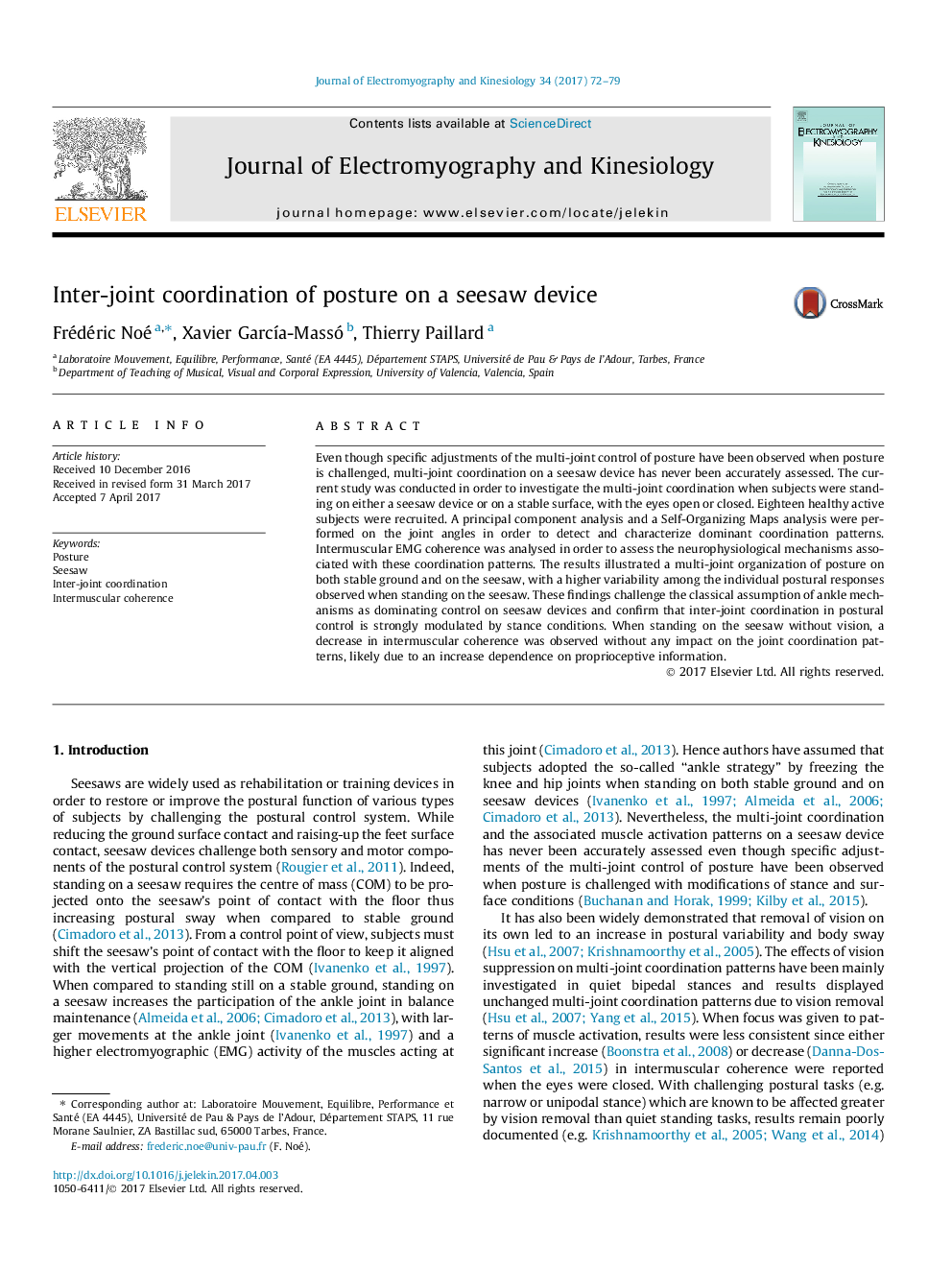| کد مقاله | کد نشریه | سال انتشار | مقاله انگلیسی | نسخه تمام متن |
|---|---|---|---|---|
| 5709555 | 1604179 | 2017 | 8 صفحه PDF | دانلود رایگان |
عنوان انگلیسی مقاله ISI
Inter-joint coordination of posture on a seesaw device
ترجمه فارسی عنوان
هماهنگی بین همجنسگرایی از موضع در یک دستگاه تند
دانلود مقاله + سفارش ترجمه
دانلود مقاله ISI انگلیسی
رایگان برای ایرانیان
کلمات کلیدی
ترجمه چکیده
با وجودی که تنظیمات خاصی از کنترل چندضلعی وضعیت در هنگام قرار گرفتن در معرض چالش دیده می شود، هماهنگی چند مفصل در یک دستگاه لرزه ای هرگز دقیق ارزیابی نشده است. مطالعه حاضر به منظور بررسی هماهنگی چند مفصل زمانی که افراد روی یک دستگاه پرده یا روی یک سطح پایدار ایستادند، با چشم باز یا بسته می شدند. هجده نفر از افراد فعال سالم استخدام شدند. تجزیه و تحلیل مولفه اصلی و تجزیه و تحلیل نقشه های سازماندهی خود را بر روی زوایای مشترک برای تشخیص و مشخص کردن الگوهای هماهنگ غالب انجام شد. برای ارزیابی مکانیزم های نوروفیزیولوژیکی مرتبط با این الگوهای هماهنگی، همبستگی الکترومغناطیسی بین جملهای مورد بررسی قرار گرفت. نتایج نشان داد که یک سازمان چند جانبه ای از وضعیت در هر دو حالت پایدار و پایدار دارد و تغییرات بالاتری در پاسخ های موضعی فردی مشاهده می شود که هنگام ایستادن بر روی ساقه دیده می شود. این یافته ها، فرض کلاسیک مکانیسم های مچ پا را به عنوان کنترل غالب بر دستگاه های ساق پا و تایید می کند که هماهنگی بین مفصل در کنترل موضعی، به شدت توسط شرایط موضع مدوله می شود. هنگامی که روی زانوبند بدون چشم ظاهر شد، کاهش انسجام بین مهره ای بدون هیچ تأثیری بر الگوهای هماهنگی مشترک، به احتمال زیاد به سبب افزایش وابستگی به اطلاعات پروپایسپتیک مشاهده شد.
موضوعات مرتبط
علوم پزشکی و سلامت
پزشکی و دندانپزشکی
ارتوپدی، پزشکی ورزشی و توانبخشی
چکیده انگلیسی
Even though specific adjustments of the multi-joint control of posture have been observed when posture is challenged, multi-joint coordination on a seesaw device has never been accurately assessed. The current study was conducted in order to investigate the multi-joint coordination when subjects were standing on either a seesaw device or on a stable surface, with the eyes open or closed. Eighteen healthy active subjects were recruited. A principal component analysis and a Self-Organizing Maps analysis were performed on the joint angles in order to detect and characterize dominant coordination patterns. Intermuscular EMG coherence was analysed in order to assess the neurophysiological mechanisms associated with these coordination patterns. The results illustrated a multi-joint organization of posture on both stable ground and on the seesaw, with a higher variability among the individual postural responses observed when standing on the seesaw. These findings challenge the classical assumption of ankle mechanisms as dominating control on seesaw devices and confirm that inter-joint coordination in postural control is strongly modulated by stance conditions. When standing on the seesaw without vision, a decrease in intermuscular coherence was observed without any impact on the joint coordination patterns, likely due to an increase dependence on proprioceptive information.
ناشر
Database: Elsevier - ScienceDirect (ساینس دایرکت)
Journal: Journal of Electromyography and Kinesiology - Volume 34, June 2017, Pages 72-79
Journal: Journal of Electromyography and Kinesiology - Volume 34, June 2017, Pages 72-79
نویسندگان
Frédéric Noé, Xavier GarcÃa-Massó, Thierry Paillard,
